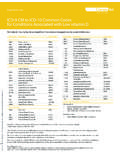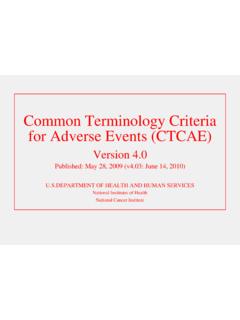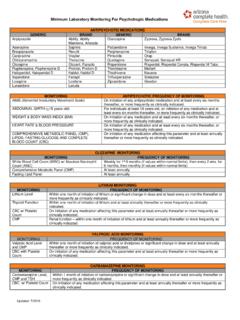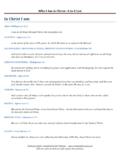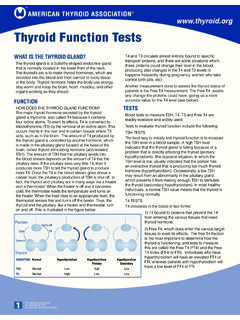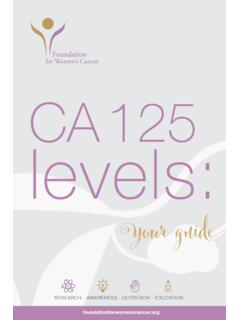Transcription of CBC (COMPLETE BLOOD COUNT) WITH DIFF
1 CBC ( complete BLOOD count ) with diff The CBC, also known as a complete BLOOD count , is a test that provides information about certain cells in the BLOOD . It is a very common and important test that is frequently ordered by a physician to check a patient s general health status. The CBC is a panel of tests which includes: WBC (White BLOOD (Leukocyte) Cell count ) a count of the actual number of white BLOOD cells per volume of BLOOD . White BLOOD cells protect the body against infection and their numbers can quickly increase when a person has a bacterial infection.
2 Both increases and decreases can be significant. WBC types include: Neutrophils, Bands (young neutrophils), Lymphocytes, Monocytes, Eosinophils, and Basophils. RBC (Red BLOOD Cell count ) a count of the actual number of red BLOOD cells per volume of BLOOD . If the RBC count is low, the body may not be getting the oxygen it needs. If the RBC count is too high (polycythemia) it may cause thickening of the BLOOD , which could increase the risk for BLOOD clots. Hemoglobin measures the amount of oxygen carrying protein in the BLOOD .
3 Hemoglobin is what gives BLOOD its red color. Hematocrit is the percentage of red BLOOD cells in the BLOOD . For example, a hematocrit of 36 means that 36% of the BLOOD 's volume is made of red BLOOD cells. Hematocrit and hemoglobin values can show if anemia or polycythemia is present. MCV (Mean Corpuscular Volume) indicates size of red BLOOD cell, MCH (Mean Corpuscular Hemoglobin) indicates amount of hemoglobin in an average red BLOOD cell, MCHC (Mean corpuscular hemoglobin concentration) measures the concentration of hemoglobin in a red BLOOD cell.
4 MCV, MCH, and MCHC all help in diagnosing different types of anemia. RDW (Red cell Distribution Width) can be measured which shows if the cells are all the same or different sizes or shapes. Platelet count The platelet (thrombocyte) count is the number of platelets in a given volume of BLOOD . Platelets are important in BLOOD clotting. If there are too few platelets, uncontrolled bleeding may be a problem. If there are too many, there is a chance of a BLOOD clot forming in a BLOOD vessel. About the Differential ( diff ) section of your CBC: The Differential is the identification of the 5 different White BLOOD cell types that are present in your BLOOD , and in what amounts.
5 This is usually completed by a highly sophisticated Hematology instrument. These instruments can have complex measuring systems to accurately indentify what white BLOOD cell types are present. If there is any thing out of the ordinary, the instrument will indicate that further investigation is needed. If this happens, the differential will be completed manually. This requires that a BLOOD smear (slide preparation) is made. A drop of BLOOD is spread on a glass slide and special dyes are used to stain the cells. It is then reviewed under a microscope by a trained Medical Technologist who evaluates the cells.
6 The WBC, RBC and Platelet cell numbers, sizes, and shapes are evaluated and recorded. This evaluation can help diagnose many BLOOD diseases like leukemia, malaria or sickle cell disease. Parts of your differential are reported in both percent and absolute values. PERCENTAGE: 100 cells are counted and the number of each type of white BLOOD cell present is expressed as a percentage. Example: 20 lymphocytes present in 100 cells = 20%. ABSOLUTE: Quantifies the real number of a specific cell type in thousands per cubic milliliter.
7 Example: WBC count is 10,000 per cubic milliliter and the differential shows 20% of the cells are lymphocytes. The absolute lymphocyte count will be 2,000. Your doctor will use the absolute number and the percentages to evaluate your condition. What should I do with my results? It is always recommended that you meet with a doctor to determine what your laboratory test results mean to you. Your doctor will review all of your test results and, combined with your health history, he or she will be able to provide an accurate picture of your health status.
8 If any of your results were abnormal or out of range: Many conditions will result in increases or decreases in the cell populations. Some of these conditions may require treatment, while others will resolve on their own. The CBC test may be ordered by the doctor on a regular basis to monitor these conditions and drug treatments. As with any abnormal results, it s important that you discuss their implications with your physician. If your results were within normal range: If all of your results are within the normal range, you should consult with your physician about the need and frequency of further CBC testing.
9 Your physician is best suited to advise you on a timetable for all screening tests. When your differential results fall into the normal range they are NOT typically associated with inflammatory disorders, anemia, viral infection, bacterial infection, or other medical conditions. Because each type of white BLOOD cell has its own role in the body s defense against infection and injury, your CBC and differential levels are best interpreted in the context of other results of your CBC ( complete BLOOD count ). It is always important to discuss your results with your physician.
10
